What Would a Harris Presidency Mean for Nuclear Policy?
The future of U.S. Nuclear Policy is on the table in the 2024 election because the president of the United States has sole authority over the decision to launch nuclear weapons as the Commander in Chief. Proponents of the Trump Administration have advocated for increasing the U.S. tactical nuclear weapons stockpile and encouraging allies like South Korea to develop their own nuclear weapons. What would a Harris Presidency mean for Nuclear Policy?
Women protesters at Greenham Commons and women groups who advocated for the treaty on the prohibitions of nuclear weapons may lead people to believe that women are less in support of nuclear weapons. However, a 2017 Stanford survey found that “women are as hawkish as men and, in some scenarios, are even more willing to support the use of nuclear weapons” in order to protect American troops. This isn’t just endemic to public opinion, when it comes to leadership, research has shown that while increasing the ratio of women in the legislature decreased the defense budget, having a women executive resulted in defense budgets raising by 3 percent. According to the study’s model, “using year 2000 spending and GDP data, the presence of a female executive would produce almost a $10.6 billion increase in U.S. defense spending.” This sentiment was reflected in Harris’s speech at the Democratic National Convention: “As commander in chief, I will ensure America always has the strongest, most lethal fighting force in the world. And I will fulfill our sacred obligation to care for our troops and their families, and I will always honor and never disparage their service and their sacrifice.” In the speech, she also said how she would be tougher than former President Trump on dictators like Kim Jong Un.
Harris has seemed to recognize the existential threat of nuclear war, responding to a question from a student in 2019, and saying “This president [Donald Trump], because he likes to sound tough as opposed to what my mother says — ‘It’s not about how you sound, it’s about how you act.’ — pulls us out of that [Iran Nuclear Deal], exposing us to great harm.” However, the current Biden-Harris Administration has continued nuclear modernization under the Sentinel program, and passed the National Defense Authorization Act, ordering the US Air Force to reduce the time it takes to upload ICBMs.
With regard to policy perspectives, some could argue there are gendered differences. Radiation from nuclear weapons fallout results in higher cases of cancer in females than males. Additionally, women face the brunt of psychological trauma from nuclear weapons attack. Because of these factors, scholars have noted the importance of including gendered analysis factors to nuclear weapons attack.
Increasing women in leadership roles is important for gender parity and bringing in new perspectives, but it does not guarantee peace. Kamala Harris’s lived experience as a woman and daughter of immigrant parents may lead her to pursue more empathetic humanitarian policies or diplomatic arms control solutions, but it does not guarantee it.
For a longer analysis on this issue, you can read more here.
FAS Receives $1.5 Million Grant on The Artificial Intelligence / Global Risk Nexus
Grant Funds Research of AI’s Impact on Nuclear Weapons, Biosecurity, Military Autonomy, Cyber, and other global issues
Washington, D.C. – September 11, 2024 – The Federation of American Scientists (FAS) has received a $1.5 million grant from the Future of Life Institute (FLI) to investigate the implications of artificial intelligence on global risk. The 18-month project supports FAS’s efforts to bring together the world’s leading security and technology experts to better understand and inform policy on the nexus between AI and several global issues, including nuclear deterrence and security, bioengineering, autonomy and lethality, and cyber security-related issues.
FAS’s CEO Daniel Correa noted that “understanding and responding to how new technology will change the world is why the Federation of American Scientists was founded. Against this backdrop, FAS has embarked on a critical journey to explore AI’s potential. Our goal is not just to understand these risks, but to ensure that as AI technology advances, humanity’s ability to understand and manage the potential of this technology advances as well.
“When the inventors of the atomic bomb looked at the world they helped create, they understood that without scientific expertise and brought her perspectives humanity would never live the potential benefits they had helped bring about. They founded FAS to ensure the voice of objective science was at the policy table, and we remain committed to that effort after almost 80 years.”
“We’re excited to partner with FLI on this essential work,” said Jon Wolfsthal, who directs FAS’ Global Risk Program. “AI is changing the world. Understanding this technology and how humans interact with it will affect the pressing global issues that will determine the fate of all humanity. Our work will help policy makers better understand these complex relationships. No one fully understands what AI will do for us or to us, but having all perspectives in the room and working to protect against negative outcomes and maximizing positive ones is how good policy starts.”
“As the power of AI systems continues to grow unchecked, so too does the risk of devastating misuse and accidents,” writes FLI President Max Tegmark. “Understanding the evolution of different global threats in the context of AI’s dizzying development is instrumental to our continued security, and we are honored to support FAS in this vital work.”
The project will include a series of activities, including high-level focused workshops with world-leading experts and officials on different aspects of artificial intelligence and global risk, policy sprints and fellows, and directed research, and conclude with a global summit on global risk and AI in Washington in 2026.
###
ABOUT FAS
The Federation of American Scientists (FAS) works to advance progress on a broad suite of contemporary issues where science, technology, and innovation policy can deliver dramatic progress, and seeks to ensure that scientific and technical expertise have a seat at the policymaking table. Established in 1945 by scientists in response to the atomic bomb, FAS continues to work on behalf of a safer, more equitable, and more peaceful world. More information at fas.org.
ABOUT FLI
Founded in 2014, the Future of Life Institute (FLI) is a leading nonprofit working to steer transformative technology towards benefiting humanity. FLI is best known for their 2023 open letter calling for a six-month pause on advanced AI development, endorsed by experts such as Yoshua Bengio and Stuart Russell, as well as their work on the Asilomar AI Principles and recent EU AI Act.
Federation of American Scientists Releases Latest India Edition of Nuclear Notebook
Washington, D.C. – September 6, 2024 – The Federation of American Scientists today released the latest India edition of the Nuclear Notebook, published in the Bulletin of the Atomic Scientists and available here. The authors, Hans Kristensen, Matt Korda, Eliana Johns, and Mackenzie Knight, estimate that India has produced enough weapons-grade plutonium for up to 210 nuclear warheads but has likely assembled closer to 172. Along with its growing arsenal, India is developing at least five new weapon systems and several new delivery platforms. Seeking to address security concerns with both Pakistan and China, India appears to be taking steps to increase the readiness of its arsenal, including “pre-mating” some of its warheads with missiles in canisters.
SSBNs and MIRVs
This Nuclear Notebook provides an overview of India’s nuclear modernization, documenting the development of new land and sea-based missiles, the retirement of older nuclear-capable systems, and the commissioning of India’s second indigenous nuclear-powered ballistic missile submarine (SSBN). The authors also analyze India’s significant progress in developing its next generation of land-based missiles with the capability to launch multiple independently targetable reentry vehicles (MIRVs).
###
ABOUT THE NUCLEAR NOTEBOOK
The FAS Nuclear Notebook, co-authored by Hans M. Kristensen, Matt Korda, Eliana Johns, and Mackenzie Knight, is published bi-monthly in the Bulletin of the Atomic Scientists. The joint publication began in 1987. FAS, formed in 1945 by the scientists who developed the nuclear weapon, has worked since to increase nuclear transparency, reduce nuclear risks, and advocate for responsible reductions of nuclear arsenals and the role of nuclear weapons in national security.
This latest issue follows the release of the 2024 North Korea Nuclear Notebook. The next issue will focus on the United Kingdom. More research is located at FAS’s Nuclear Information Project.
The Federation of American Scientists’ work on nuclear transparency would not be possible without generous support from the Carnegie Corporation of New York, Longview Philanthropy, the Jubitz Foundation, the New-Land Foundation, Ploughshares, the Prospect Hill Foundation, and individual donors.
ABOUT FAS
The Federation of American Scientists (FAS) works to advance progress on a broad suite of contemporary issues where science, technology, and innovation policy can deliver dramatic progress, and seeks to ensure that scientific and technical expertise have a seat at the policymaking table. Established in 1945 by scientists in response to the atomic bomb, FAS continues to work on behalf of a safer, more equitable, and more peaceful world. More information at fas.org.
Hot-Launch Yoga: Cobra Pose Reveals Nuke Repose
The Indian Navy has integrated yoga into its training practices for decades, and in recent years it has conducted yoga sessions onboard its warships during port visits as a form of cultural diplomacy. These events, and the social media posts documenting them, occasionally offer fascinating data points about the status of specific military capabilities.
In particular, yoga-related social media posts and satellite imagery now indicate that one of India’s oldest naval missiles capable of launching nuclear weapons has likely been retired as the country continues to develop its sea-based nuclear deterrent.
For nearly 15 years, India’s naval nuclear forces solely consisted of two offshore patrol vessels that had been specially configured to launch nuclear-capable Dhanush missiles.
The Dhanush––a variant of India’s Prithvi short-range ballistic missile––had always been somewhat of an odd capability for India’s navy. Given its relatively short range and liquid-fuel design––meaning that it would need to be fueled immediately prior to launch––the Dhanush’s utility as a strategic deterrence weapon was severely limited. The ships carrying these missiles would have to sail dangerously close to the Pakistani or Chinese coasts to target facilities in those countries, making them highly vulnerable to counterattack.
For those reasons, we have continuously assessed that as India’s long-planned nuclear-powered ballistic missile submarines become operational, the Dhanush would eventually be phased out.
New data points from social media and satellite imagery indicate it is very likely that this has now happened.
––
For years, India’s nuclear-capable Dhanush missiles were carried by two specially configured Sukanya-class offshore patrol vessels, known as INS Subhadra (hull number P51) and INS Suvarna (P52). These two vessels have been most clearly distinguishable from India’s four other Sukanya-class patrol vessels by the presence of missile stabilizer platforms on their aft decks that could be clearly seen through satellite imagery, including in this image from April 2018.
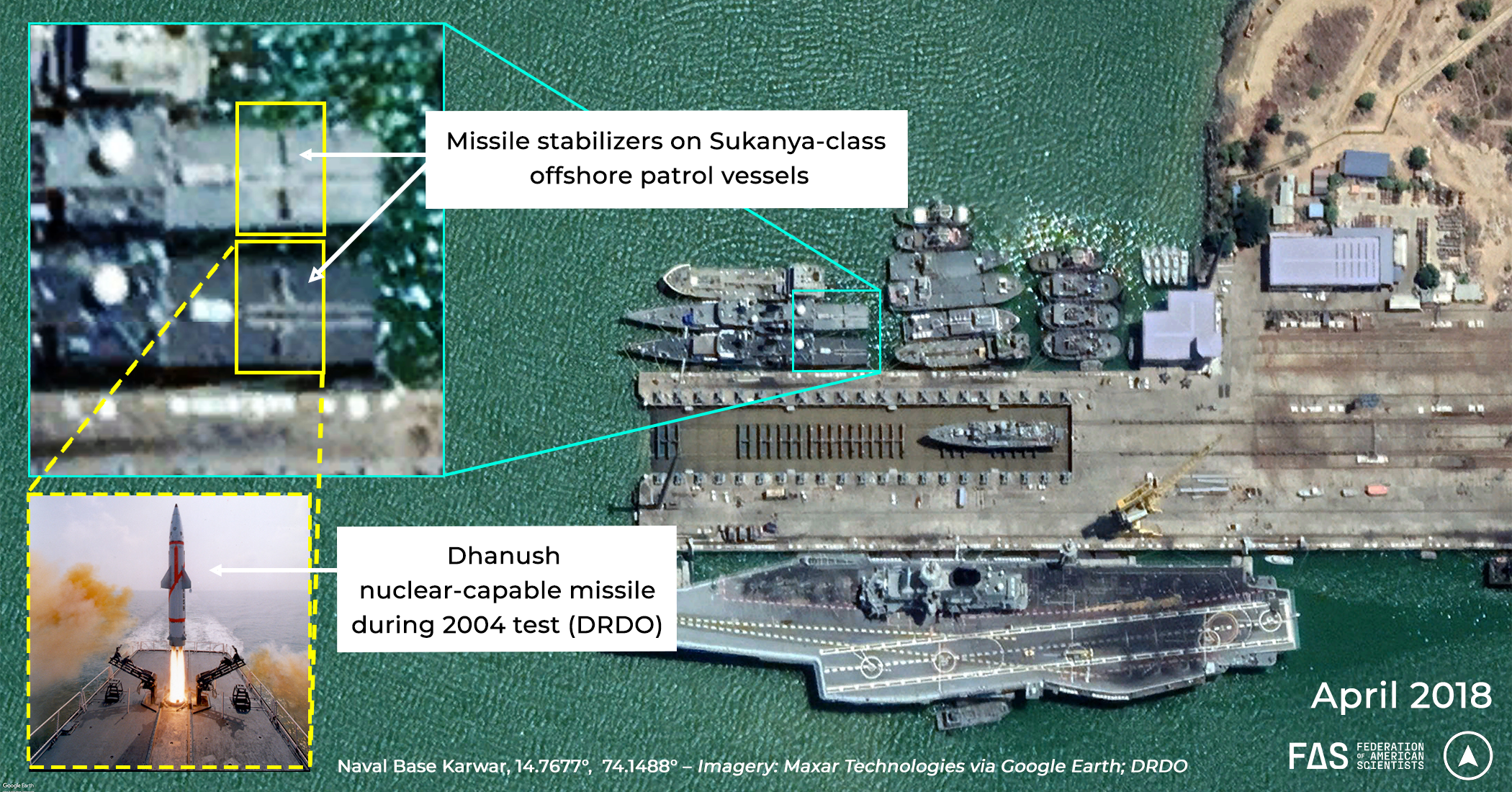
The last time that any official Indian source had indicated that the Dhanush capability was still operational was in 2019, when two Facebook posts by the Indian Navy’s official page specifically mentioned the capability and implied that it was still active on both INS Subhadra and INS Suvarna.
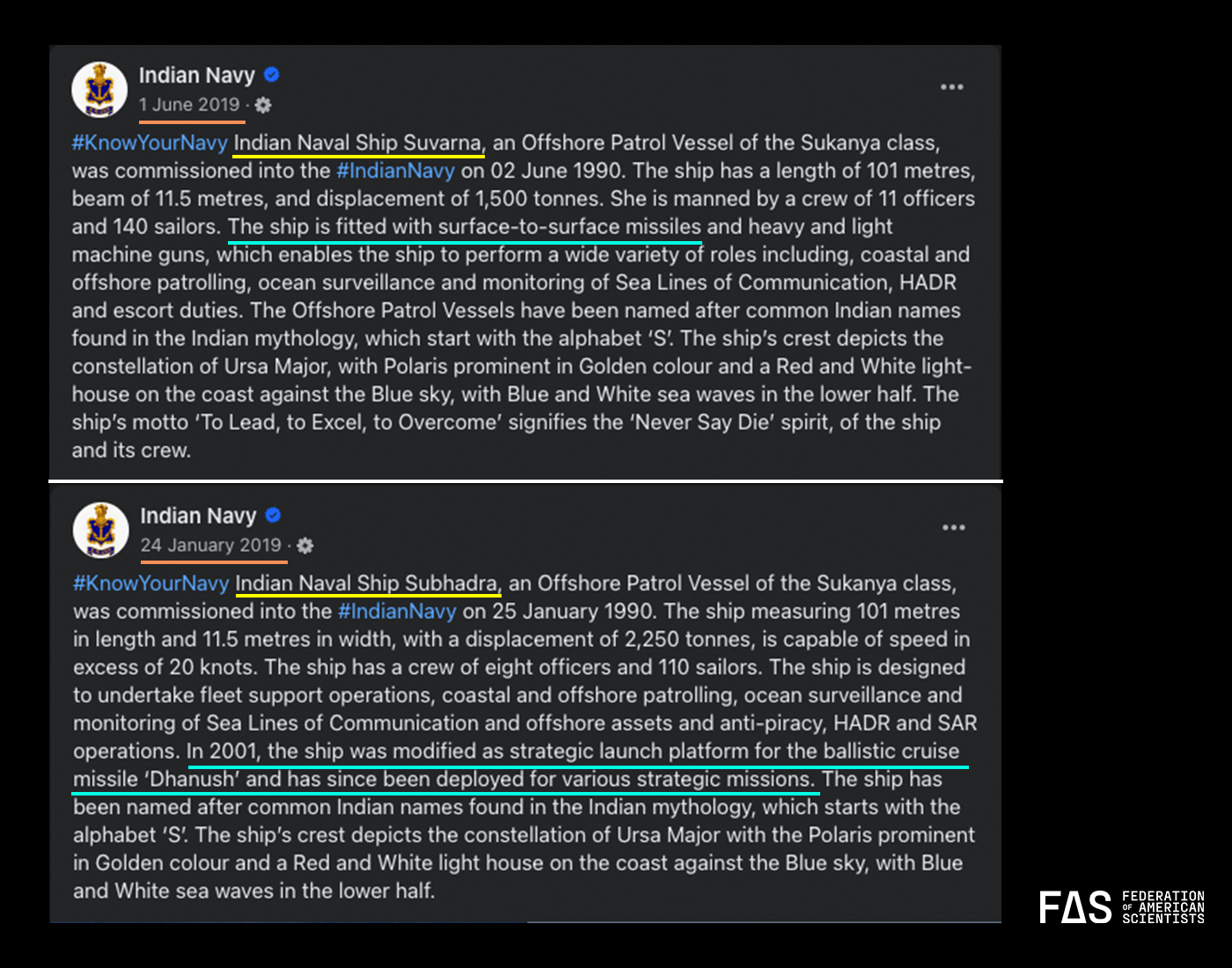
In December 2021, satellite imagery from Airbus showed two Sukanya-class vessels at Naval Base Karwar, one with missile stabilizers and the other without. The vessel without stabilizers also featured new aft deck markings in a cross pattern that had not been seen before on other vessels of that class. Without additional images, it was unclear whether the vessel featuring the new markings was one of the two nuclear-capable ships or another ship in the Sukanya-class that is also home-ported at Karwar––INS Sukanya (P50). If the vessel without stabilizers was the INS Sukanya, then the markings on the ship would not have necessarily indicated any change to the nuclear mission, since INS Sukanya had never been equipped with missile stabilizers. If the new pattern belonged to one of the two vessels that had previously been equipped with those stabilizers, however, then it would indicate that those stabilizers had been removed, thus likely eliminating that vessel’s nuclear strike role and removing the Dhanush missile from combat duty.
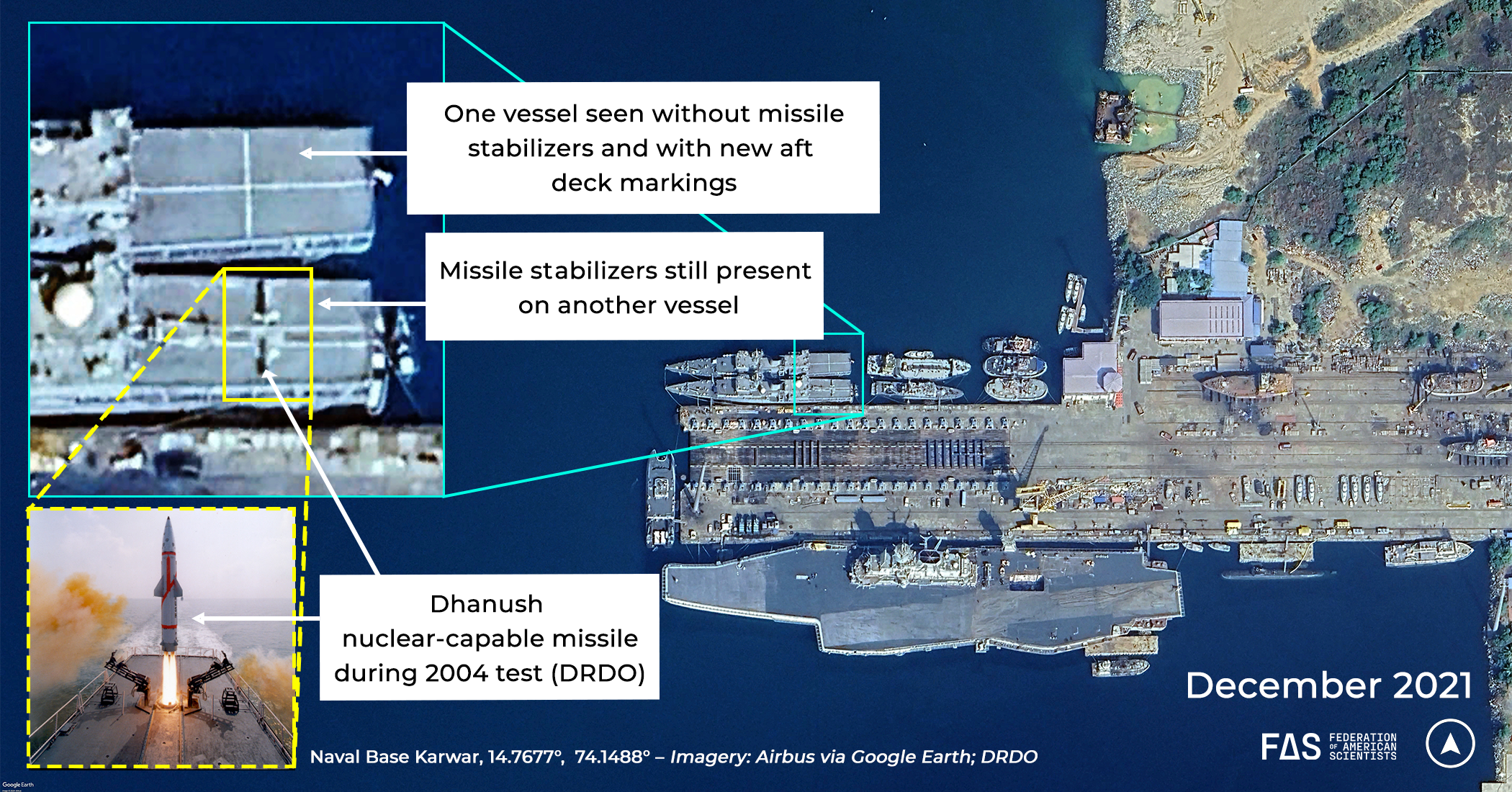
Clarity arrived through a strange medium: a series of yoga-related Instagram posts published by India’s public broadcaster during port visits to Seychelles in October 2022, indicating that the vessel with the new deck markings was indeed INS Suvarna. This meant that as of December 2021 at the latest, the missile stabilizers on INS Suvarna had been removed, meaning that the vessel has since been unable to launch nuclear-capable Dhanush ballistic missiles.
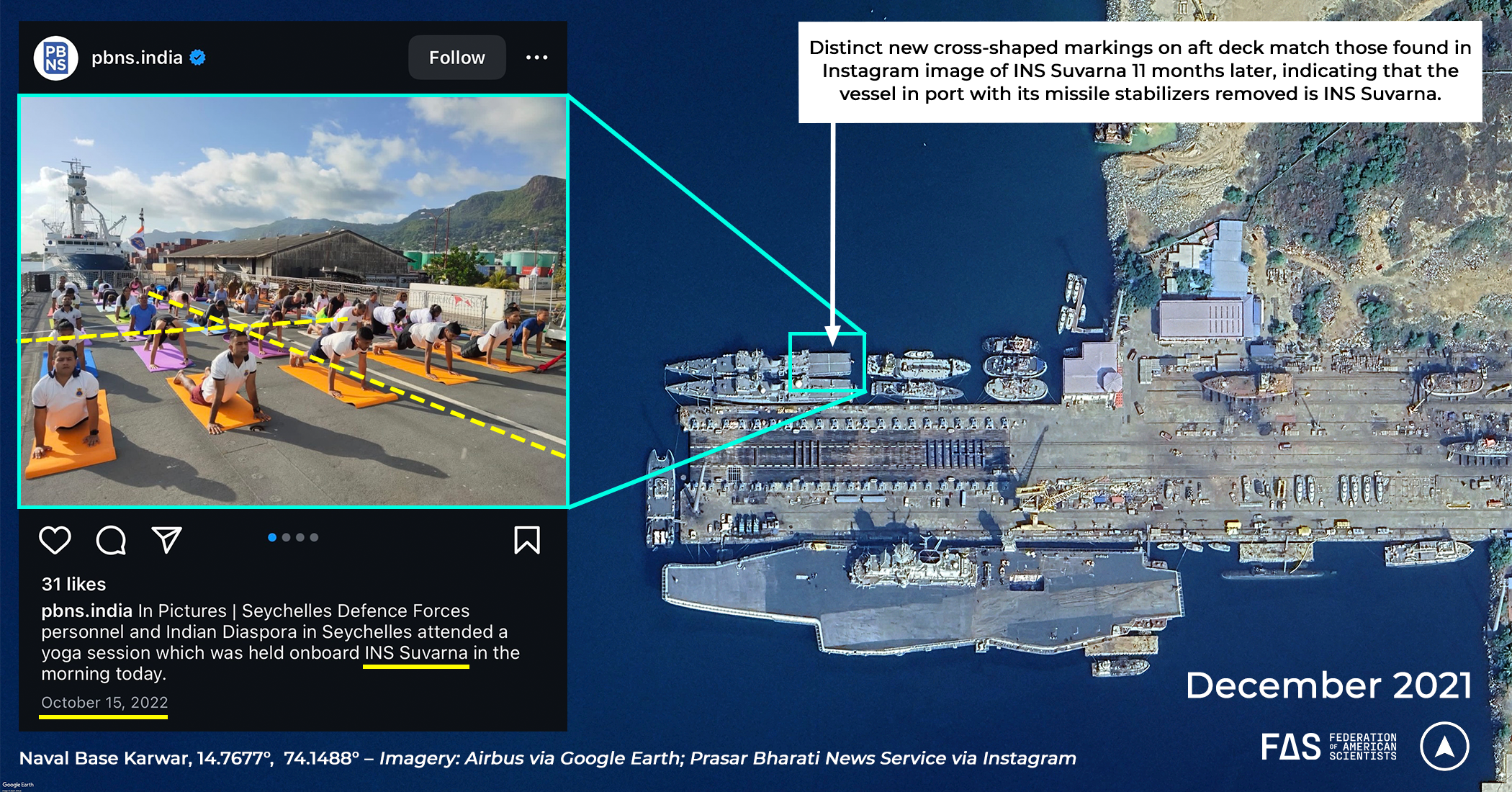
At the exact same time that the crew of INS Suvarna was practicing yoga in Seychelles, another satellite image captured by Maxar Technologies showed another Sukanya-class patrol vessel at Naval Base Karwar with its aft deck under construction. Similarly to the previous case, it remained unclear whether this vessel was the nuclear-capable INS Subhadra or the non-nuclear INS Sukanya. A subsequent satellite image in April 2023 indicated that the aft deck had been repainted with a new cross pattern with a circle––likely to be used as a helipad.
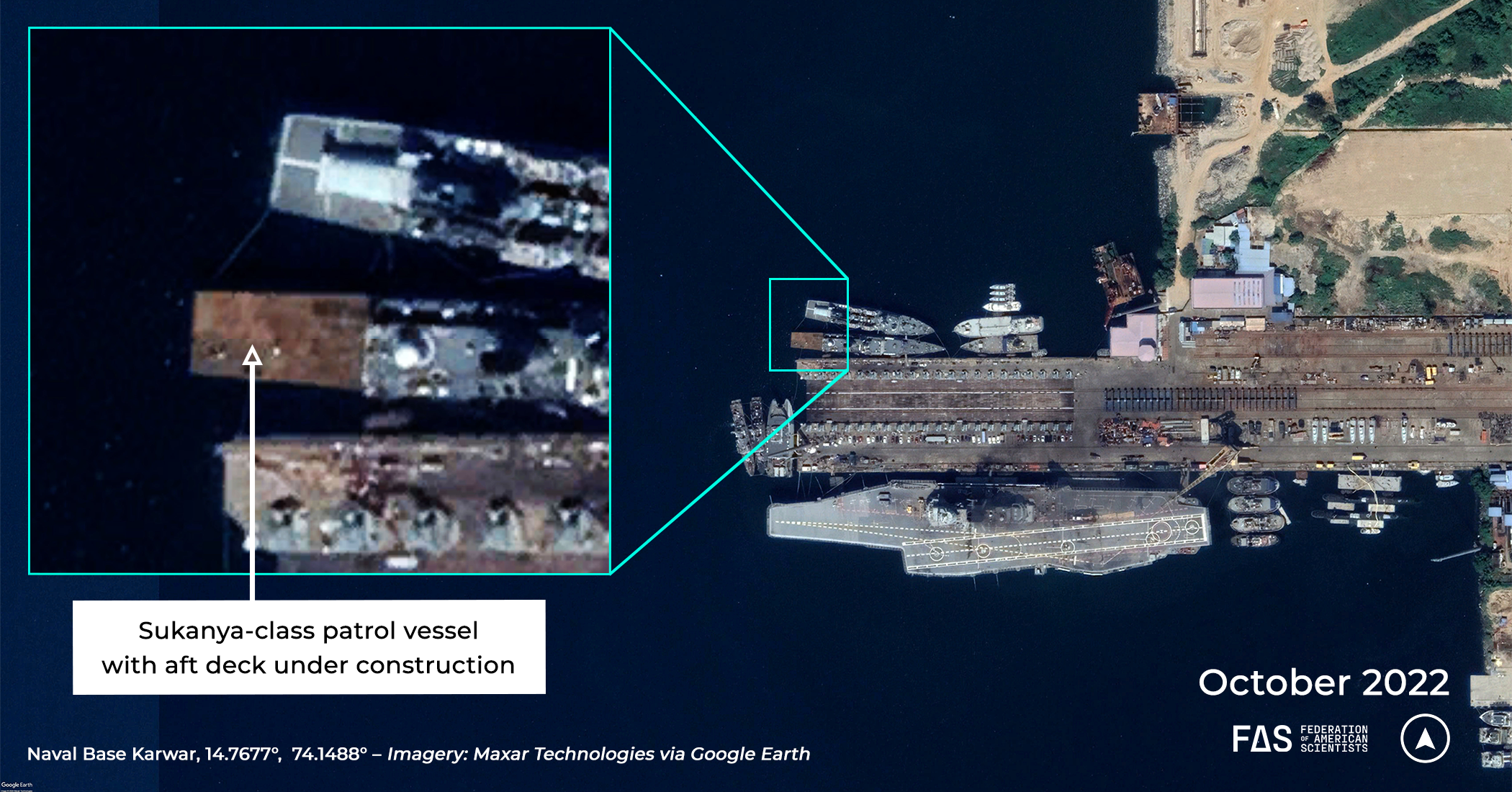
This same unique deck pattern was then on full display at another yoga session in Seychelles, during a port visit by INS Subhadra in February 2024. This indicates that this vessel lost its ability to deliver nuclear-capable Dhanush missiles when its aft deck began construction around October 2022.

Since then, neither vessel has been seen with its missile stabilizer platforms returned to the aft deck, suggesting that the nuclear-capable Dhanush has finally been removed from active service and that the nuclear strike mission for the Sukanya-class patrol vessels has likely been retired. Given that the Dhanush is a close variant of India’s land-based Prithvi SRBM, it is likely that the Dhanush’s associated warheads have not been dismantled, but instead have been returned to India’s stockpile for use by these short-range systems.
—
Although the yoga-related source of the news may have been surprising, the Dhanush missile’s retirement in itself was not. For years, we have assumed that the system would be eliminated once India’s sea-based deterrent reached a higher level of maturity. That time appears to be now: after years of delays, India’s second ballistic missile submarine––INS Arighat––is expected to be commissioned into the Navy before the end of 2024. Two more ballistic missile submarines are expected to follow over the course of this decade, and satellite imagery indicates that they will be able to carry double the number of missiles as India’s first two submarines.
More details on these developments, as well as other elements of India’s evolving nuclear arsenal, will be available in our forthcoming September publication: Indian Nuclear Weapons, 2024, in the Bulletin of the Atomic Scientists.
This research was carried out with generous contributions from the Carnegie Corporation of New York, the Jubitz Foundation, the New-Land Foundation, Ploughshares, the Prospect Hill Foundation, and individual donors.
United States Discloses Nuclear Warhead Numbers; Restores Nuclear Transparency

Note: The initial NNSA release showed an incorrect graph that did not accurately depict the size of the stockpile for the period 2012-2023. The corrected graph is shown above.
[UPDATED VERSION] The Federation of American Scientists applauds the United States for declassifying the number of nuclear warheads in its military stockpile and the number of retired and dismantled warheads. The decision is consistent with America’s stated commitment to nuclear transparency, and FAS calls on all other nuclear states to follow this important precedent.
The information published on the National Nuclear Security Administration (NNSA) web site today shows that the U.S. nuclear weapons stockpile as of September 2023 included 3,748 nuclear warheads, only 40 warheads off FAS’ estimate of 3,708 warheads.
The information also shows that the United States last year dismantled only 69 retired nuclear warheads, the lowest number since 1994.
FAS has previously requested that the United States release the size of the US nuclear arsenal for FY2021, FY2022, and FY2023, but those requests were denied. FAS believes the information was wrongly withheld and that today’s declassification decision vindicates our belief that stockpile disclosures do not negatively affect U.S. security but should be provided to the public.
With today’s announcement, the Biden Administration has restored the nuclear stockpile transparency that was created by the Obama administration, halted by the Trump administration, revived by Biden administration in its first year, but then halted again for the past three years.
While applauding the U.S. disclosure, FAS also urged other nuclear-armed states to disclose their stockpile numbers and warheads dismantled. Excessive nuclear secrecy creates mistrust, fuels worst-case planning, and enables hardliners and misinformers to exaggerate nuclear threats.
What The Nuclear Numbers Show
The declassified stockpile numbers show that the United States maintained a total of 3,748 warheads in its military stockpile as of September 2023. The military stockpile includes both active and inactive warheads in the custody of the Department of Defense. The information also discloses weapons numbers for the previous two years, numbers that the U.S. government had previously declined to release.
Although there have minor fluctuations, the numbers show that the U.S. nuclear weapons stockpile has remained relative stable for the past seven years. The fluctuations during that period do not reflect decision to increase or decrease the stockpile but are the result of warheads movements in and out of the stockpile as part of the warhead life-extension and maintenance work.
Although the warhead numbers today are much lower than during the Cold War and there have been reductions since 2000, the reduction since 2007 has been relatively modest. Although the New Start treaty has had some indirect effect on the stockpile size due to reduced requirement, the biggest reductions since 2007 have be caused by changes in presidential guidance, strategy, and modernization programs. The initial chart released by NNSA did not accurately show the 1,133-warhead drop during the period 2012-2023. NNSA later corrected the chart (see top of article). The chart below shows the number of warheads in the stockpile compared with the number of warheads deployed on strategic launchers over the years.
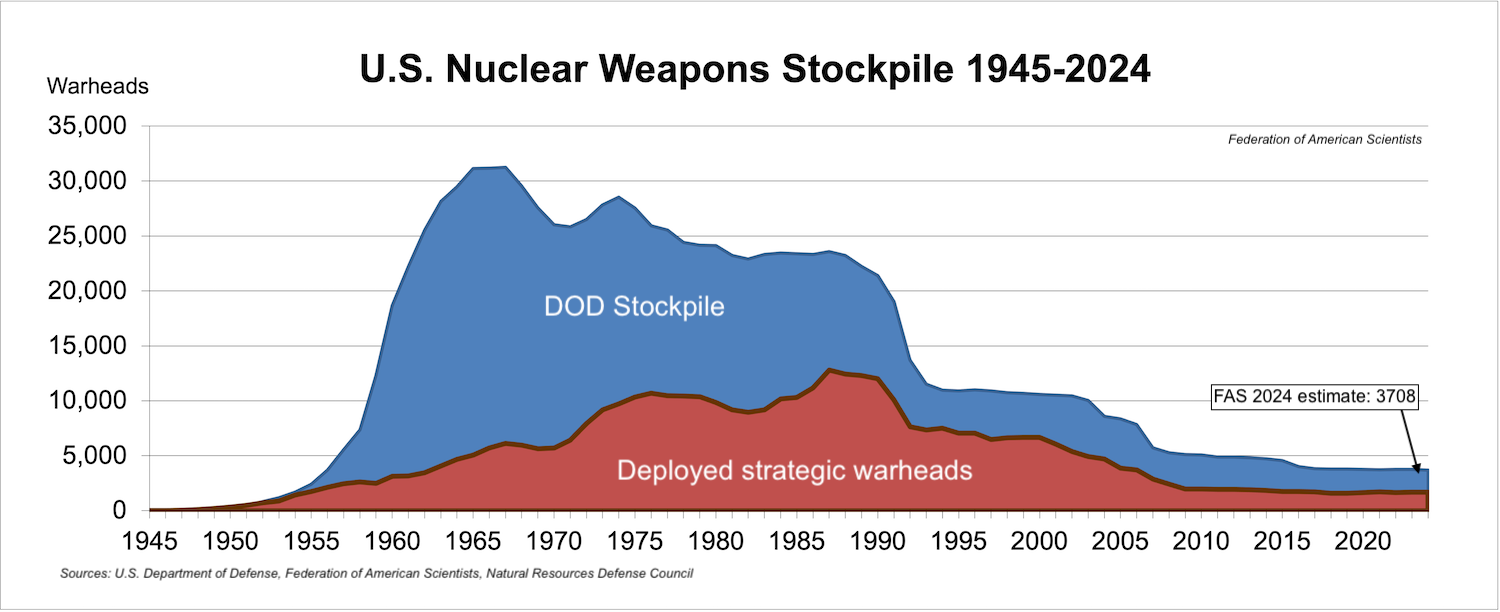
This graph shows the size of the U.S. nuclear stockpile over the years plus the portion of those warheads deployed on strategic launchers. The stockpile number for 2024 and the strategic launcher warheads are FAS estimates.
The information also shows that the United States last year dismantled only 69 retired nuclear warheads. That is the lowest number of warheads dismantled in a year since 1994. The total number of retired nuclear warheads dismantled 1994-2023 is 12,088. Retired warheads awaiting dismantlement are not in the DOD stockpile but in the DOE stockpile.
The information disclosed also reveals that there are currently another approximately 2,000 retired warheads in storage awaiting dismantlement. This number is higher than our most recent estimate (1,336) because of the surprisingly low number of warheads dismantled in recent years. Because dismantlement appears to be a lower priority, the number of retired weapons awaiting dismantlement today (~2,000) is only 500 weapons lower than the inventory was in 2015 (~2,500).
FAS’ Work For Nuclear Transparency
The Federation of American Scientists has worked since its creation to increase responsible transparency on nuclear weapons issues; in fact, the nuclear scientists that built the bomb created the “Federation of Atomic Scientists” to enable some degree of transparency to discuss the implications of nuclear weapons (see FAS newsletter from 1949). There are of course legitimate nuclear secrets that must remain so, but nuclear stockpile numbers are not among them.

This FAS newsletter from 1949 describes the debate and FAS effort in support of transparency of the US weapons stockpile.
One part of FAS’ efforts, spearheaded by Steve Aftergood who for many years directed the FAS Project on Government Secrecy, has been to report on the government’s discussions about what needs to be classified and repeatedly request declassification of unnecessary secrets such as the stockpile numbers. This work yielded stockpile declassifications in some years (2012-2018, 2021) while in other years (2019-2020 and 2022-2024) FAS’ declassified requests were initially denied. Most recently, in February 2024, an FAS declassification request for the stockpile numbers as of 2023 was denied, although the letter added: “If a different decision is made in the future, we will notify you of this decision” (see rejection letters). Given these denials, FAS in March 2024 sent a letter to President Biden outlining the important reasons for declassifying the numbers.
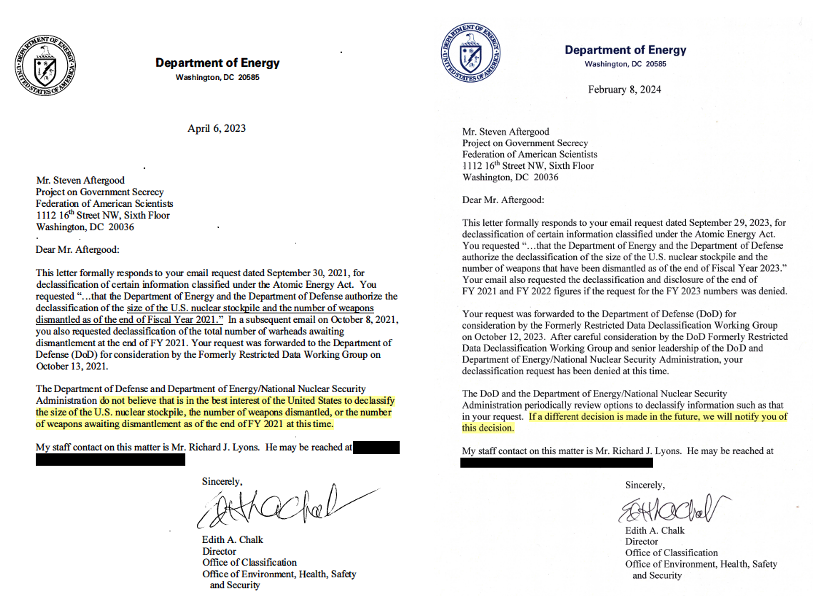
The new disclosure of the stockpile numbers suggests that denial of earlier FAS declassification requests in 2023 and 2024 may not have been justified and that future years’ numbers should not be classified.
The other part of FAS’ efforts has been the Nuclear Information Project, which works to analyze, estimate, and publish information about the U.S. nuclear arsenal. In 2011, when the Obama administration first declassified the history of the stockpile, the FAS estimate was only 13 warheads off from the official number of 5,112 warheads. The Project also works to increase transparency of the other nuclear-armed states by providing the public with estimates of their nuclear arsenals. The project described the structures that enabled Matt Korda on our team and others to discover the large missile silo fields China was building, and NATO officials say our data is “the best for open source information that doesn’t come from any one nation.”
Why Nuclear Transparency Is Important
FAS has since its founding years worked for maximum responsible disclosure of nuclear weapons information in the interest of international security and democratic values. In a letter to President Biden in March 2024 we outlined those interests.

After denials in 2023 and February 2024 of FAS declassification requests, FAS in March sent President Biden a letter outlining why the denials were wrong. Click here to download full version of letter.
First, responsible transparency of the nuclear arsenal serves U.S. security interests by supporting deterrence and reassurance missions with factual information about U.S. capabilities. Equally important, transparency of stockpile and dismantlement numbers demonstrate that the United States is not secretly building up its arsenal but is dismantling retired warheads instead of keeping them in reserve. This can help limit mistrust and worst-case scenario planning that can fuel arms races.
Second, the United States has for years advocated and promoted nuclear transparency internationally. Part of its criticism of Russia and China is their lack of disclosure of basic information about their nuclear arsenals, such as stockpile numbers. U.S. diplomats have correctly advocated for years about the importance of nuclear transparency, but their efforts are undermined if stockpile and dismantlement numbers are kept secret because it enables other nuclear-armed states to dismiss the United States as hypocritical.
Third, nuclear transparency is important for the debate in the United States (and other Allied democracies) about the status and future of the nuclear arsenal and strategy and how the government is performing. Opponents of declassifying nuclear stockpile numbers tend to misunderstand the issue by claiming that disclosure gives adversaries a military advantage or that the United States should not disclose stockpile numbers unless the adversaries do so as well. But nuclear transparency is not a zero-sum issue but central to the democratic process by enabling informed citizens to monitor, debate, and influence government policies. Although the U.S. disclosure is not dependent on other nuclear-armed states releasing their stockpile numbers, Allied countries such as France and the United Kingdom should follow the U.S. example, as should Russia and China and the other nuclear-armed states.
Acknowledgement: Mackenzie Knight, Jon Wolfsthal, and Matt Korda provided invaluable edits.
More information on the FAS Nuclear Information Project page.
This research was carried out with generous contributions from the Carnegie Corporation of New York, the New-Land Foundation, the Ploughshares Fund, the Prospect Hill Foundation, Longview Philanthropy, and individual donors.
North Korean Nuclear Weapons, 2024: Federation of American Scientists Release Latest North Korea Nuclear Weapons Estimate
North Korea continues to modernize and grow its nuclear weapons arsenal
Washington, D.C. – July 15, 2024 – The Federation of American Scientists today released the North Korea edition of the Nuclear Notebook, published in the Bulletin of the Atomic Scientists and available here. The authors, Hans Kristensen, Matt Korda, Eliana Johns, and Mackenzie Knight, estimate that North Korea may have produced enough fissile material to build up to 90 nuclear warheads, but the famously opaque country has likely assembled fewer than that—potentially around 50. This is not a significant change from previous estimates (2021, 2022) but follows the trendline researchers are tracking. North Korea’s abandonment of a no-first-use policy coincides with the country’s recent efforts to develop tactical nuclear weapons.
Warhead Preparation and Delivery
While its status remains unclear, North Korea has developed a highly diverse missile force in all major range categories. In this edition of the Nuclear Notebook, FAS researchers documented North Korea’s short-range tactical missiles, sea-based missiles, and new launch platforms such as silo-based and underwater platforms Additionally, FAS researchers provided an overview of North Korea’s advancements in solid-fuel missile technology, which will improve the survivability and mobility of its missile force.
“Since 2006, North Korea has detonated six nuclear devices, updated its nuclear doctrine to reflect the irreversible role of nuclear weapons for its national security, and continued to introduce a variety of new missiles test-flown from new launch platforms,” says Hans Kristensen, director of FAS’s Nuclear Information Project.
The size and composition of North Korea’s nuclear stockpile depends on warhead design and the number and types of launchers that can deliver them.
Disco Balls, Peanuts, and Olives
Researchers informally refer to North Korea’s nuclear warhead designs as the disco ball, peanut, and olive based on their appearance in North Korean state media. These images, taken from this recent issue of the North Korea Nuclear Notebook, show supposed warhead designs, including a single-stage implosion device (nicknamed “disco-ball”), a new miniaturized warhead called the Hwasan-31 (nicknamed “olive”), and a two-stage thermonuclear warhead (nicknamed “peanut”).
Caption: Images from the Nuclear Notebook: North Korea, 2024. Top left “disco ball”, top right “olive”, bottom left “peanut”. (Source: Federation of American Scientists).
While North Korea’s warhead design and stockpile makeup are not verifiable, it is possible that most weapons are single-stage fission weapons with yields between 10 and 20 kilotons of TNT equivalent, akin to those demonstrated in the 2013 and 2016 tests. A smaller number could be composite-core single-stage warheads with a higher yield.
The Hwasan-31, first showcased in 2023, demonstrates North Korea’s progress towards developing and fielding short-range, or tactical, nuclear weapons. In addition to the development and demonstration of new long-range strategic nuclear-capable missiles, the pursuit of tactical nuclear weapons appears intended to provide options for nuclear use below the strategic level and to strengthen North Korea’s regional deterrence posture.
###
ABOUT THE NUCLEAR NOTEBOOK
The FAS Nuclear Notebook, co-authored by Hans M. Kristensen, Matt Korda, Eliana Johns, and Mackenzie Knight, is published bi-monthly in the Bulletin of the Atomic Scientists. The joint publication began in 1987. FAS, formed in 1945 by the scientists who developed the nuclear weapon, has worked since to increase nuclear transparency, reduce nuclear risks, and advocate for responsible reductions of nuclear arsenals and the role of nuclear weapons in national security.
This latest issue follows the release of the 2024 United States Nuclear Notebook. The next issue will focus on India. More research is located at FAS’s Nuclear Information Project.
ABOUT FAS
The Federation of American Scientists (FAS) works to advance progress on a broad suite of contemporary issues where science, technology, and innovation policy can deliver dramatic progress, and seeks to ensure that scientific and technical expertise have a seat at the policymaking table. Established in 1945 by scientists in response to the atomic bomb, FAS continues to work on behalf of a safer, more equitable, and more peaceful world. More information at fas.org.
Nuclear Experts from the Federation of American Scientists Call for More Transparency from the Defense Department with Its Decision to Certify the Sentinel ICBM Program
The Air Force’s flawed assumptions, processes, and estimation methodologies have led to unprecedented cost overruns
Washington, D.C. – July 9, 2024 – The Federation of American Scientists (FAS) stands with fellow scientists and peer organizations critiquing the Biden administration’s decision to certify the Sentinel ICBM program, despite it being 81% over budget and two to three years behind schedule. This program does not improve American safety or global peace efforts, and is an unnecessary financial burden on taxpayers.
The Pentagon’s review of the Sentinel came after the projected cost of the project rose by 37 percent, to $131 billion––requiring a re-evaluation of the program and a consideration of possible alternatives under the Nunn-McCurdy Act. Recent reporting from Bloomberg indicates that the Sentinel’s costs are now estimated to rise to $141 billion. This represents an 81 percent increase from the Pentagon’s own estimate in 2020.
“You can be for nuclear weapons modernization and think this program is both in trouble and needs a serious re-examination. At 81% over budget and $140 billion and climbing, we owe it to consider real alternatives and get modernization right,” says Jon Wolfsthal, Director of Global Risk at FAS.
In its justification decision, the Pentagon suggested that the Nunn-McCurdy review team considered “‘four to five different options,’ including extending the aging Minuteman III missiles in 2070, ‘hybrid options of different ground facilities, mobile versus fixed,’ and others.” However, the Pentagon’s stated justifications for continuing the program, its timelines, and its funding are all questioned by the FAS team.
Associate Director for FAS’ Nuclear Information Project, Matt Korda, asks: “Where does the year 2070 come from? The Air Force previously referred to the year 2075 in its program documentation, and as far as I know, neither year is codified in any official policy documents like the National Defense Strategy or the Nuclear Posture Review. Yet these benchmarks have enormous bearing on cost estimates, and can be purposely selected to tip the scales and make some options look more palatable than others.” Korda wrote a detailed report in 2021 showing how changes in these cost benchmarks would have indicated that alternatives to the Sentinel––such as life-extending the current fleet of Minuteman III ICBMs––would very likely have been cheaper than building an entirely brand-new weapon system.
Director of FAS’s Nuclear Information Project, Hans Kristensen, is more pointed in his criticism: “Despite massively escalating cost projection, having sold the new Sentinel ICBM program to Congress based on unrealistic cost, the Pentagon says go ahead anyway.”
Kristensen and Korda are leading researchers on the global stockpile of nuclear weapons. Along with their colleagues, Senior Research Associates Eliana Johns and Mackenzie Knight, they produce and distribute, in conjunction with the Bulletin of the Atomic Scientists, the Nuclear Notebook, detailed reports on the status of nuclear weapons worldwide.
Knight was among the first to identify Sentinel’s extreme cost overruns and raise public awareness of this issue. In March she wrote what should happen next:
Secretary Austin’s likely certification of the Sentinel program should be open to public interrogation, and Congress must thoroughly examine whether every requirement is met before allowing the program to continue. Congress should ask the Government Accountability Office and Congressional Budget Office to conduct independent reviews to interrogate the Pentagon’s justification for Sentinel and ensure hawk-eyed scrutiny of the program’s next steps.
The Hill, March 1, 2024
She adds now: “The Sentinel program being allowed to continue despite an 81% cost increase sets a dangerous precedent. Whether the program is flawed, necessary, or not, Congress and the administration should not allow ostensibly limitless spending on nuclear weapons programs. How much is too much?”
More than 700 scientists, including ten Nobel laureates and 23 members of the National Academies, have signed a letter calling for President Biden and Congress to cancel the program, led by the Union of Concerned Scientists.
###
ABOUT FAS
The Federation of American Scientists (FAS) works to advance progress on a broad suite of contemporary issues where science, technology, and innovation policy can deliver dramatic progress, and seeks to ensure that scientific and technical expertise have a seat at the policymaking table. Established in 1945 by scientists in response to the atomic bomb, FAS continues to work on behalf of a safer, more equitable, and more peaceful world. More information at fas.org.
Photo Depicts Potential Nuclear Mission for Pakistan’s JF-17 Aircraft
Due to longstanding government secrecy, analyzing Pakistan’s nuclear weapons program is fraught with uncertainties. While it is known that Pakistan–along with many other nuclear-armed states–is modernizing its nuclear capabilities and fielding new weapons systems, little official information has been released regarding these plans or the status of its arsenal.
One of the many questions researchers have been asking concerns the modernization of Pakistan’s nuclear-capable aircraft and its associated air-launched cruise missiles (ALCM). It has been long assumed that the Mirage III and Mirage V fighter bombers are the two aircraft with a nuclear delivery role in the Pakistan Air Force (PAF). The Mirage V is thought to have a strike role with Pakistan’s limited supply of nuclear gravity bombs, while the Mirage III has been used to conduct test launches of Pakistan’s dual-capable Ra’ad-I (Hatf-8) ALCM, as well as the follow-on Ra’ad-II. The Ra’ad ALCM was first tested in 2007 and has since remained Pakistan’s only nuclear-capable air-launched cruise missile.
The U.S. Air Force National Air and Space Intelligence Center (NASIC) reported in 2017 that the Ra’ad cruise missile was “conventional or nuclear,” a term normally used to describe a dual-capable system.
In order to retire its aging Mirage III and V aircraft and bolster defense production, Pakistan has procured over 130 operational JF-17 aircraft–which are jointly produced with China–and plans to acquire more in the future. During the 2024 Pakistan Day Parade, the PAF also announced a JF-17 PFX (Pakistan Fighter Experimental) project to maximize the operational lifespan and modernize the capabilities of the JF-17 aircraft.
Over the past few years, several reports have suggested Pakistan may incorporate the dual-capable Ra’ad ALCM onto the JF-17 so that the newer aircraft could eventually take over the nuclear strike role from the Mirage III/Vs. However, little information has been revealed about the status of this procurement and whether the JF-17s will replace the Mirage III and Vs in the nuclear mission. That is, until March 2023, when an aviation photographer captured an image that could help answer some of these lingering questions.
A possible new nuclear mission
During rehearsals for the 2023 Pakistan Day Parade (which was subsequently canceled), an image surfaced of a JF-17 Thunder Block II carrying what was reported to be a Ra’ad ALCM. Notably, this was the first time such a configuration had been observed in public.
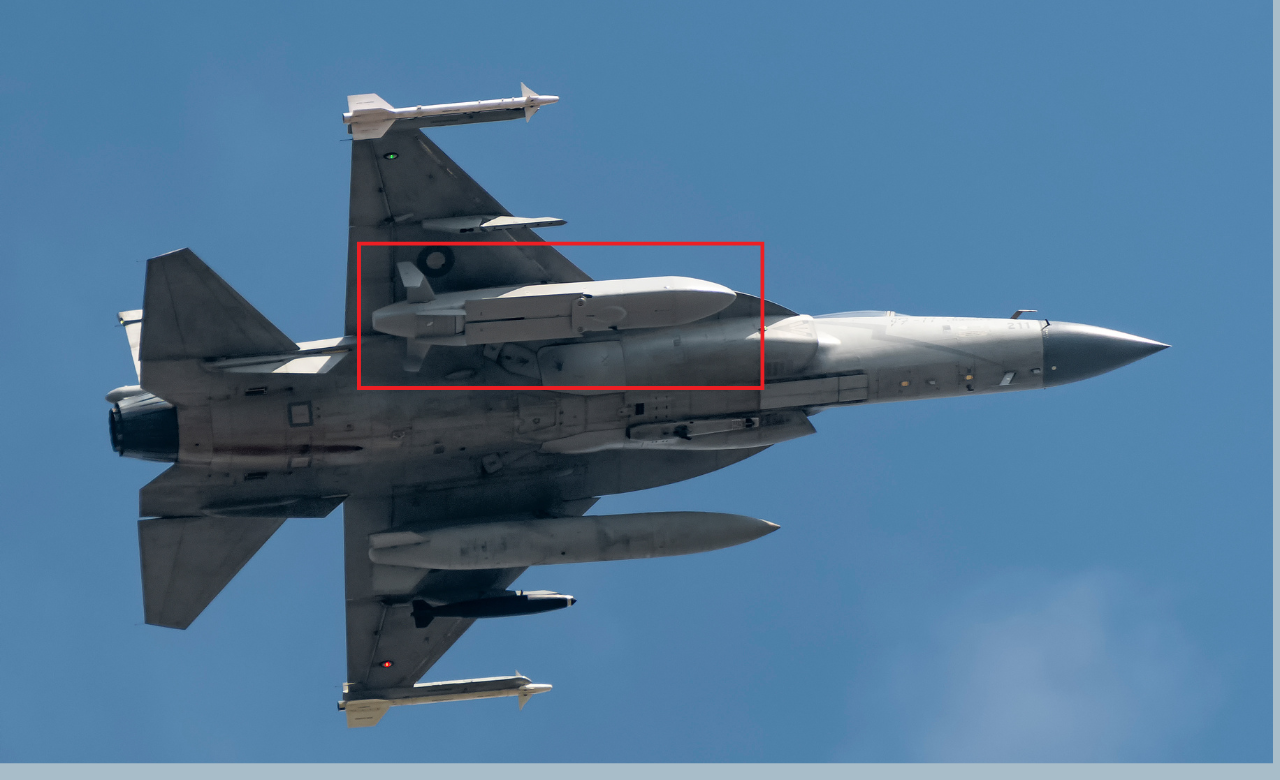
Photo credit: Rana Suhaib/Snappers Crew
FAS was able to purchase the original image. To try and ascertain which type of Ra’ad is in the JF-17 image–the original Ra’ad-I or the extended-range Ra’ad-II–we compared it to other Ra’ad-I and -II missiles displayed in the 2017, 2018, 2019, 2021, 2022, and 2024 Pakistan Day Parades (the parades in 2020 and 2023 were canceled) where the Ra’ad-I and Ra’ad-II were showcased alongside other nuclear-capable missiles such as the Nasr, Ghauri, Shaheen-IA and -II, as well as the Babur-1A.
Between 2017–when the Ra’ad-II was first publicly unveiled–and 2022, there were very few observable differences between the Ra’ad-I and -II. During this period, both missiles featured a new engine air intake, and although the Ra’ad-II was presented as having nearly double the range capability, this was not clearly observable through external features.
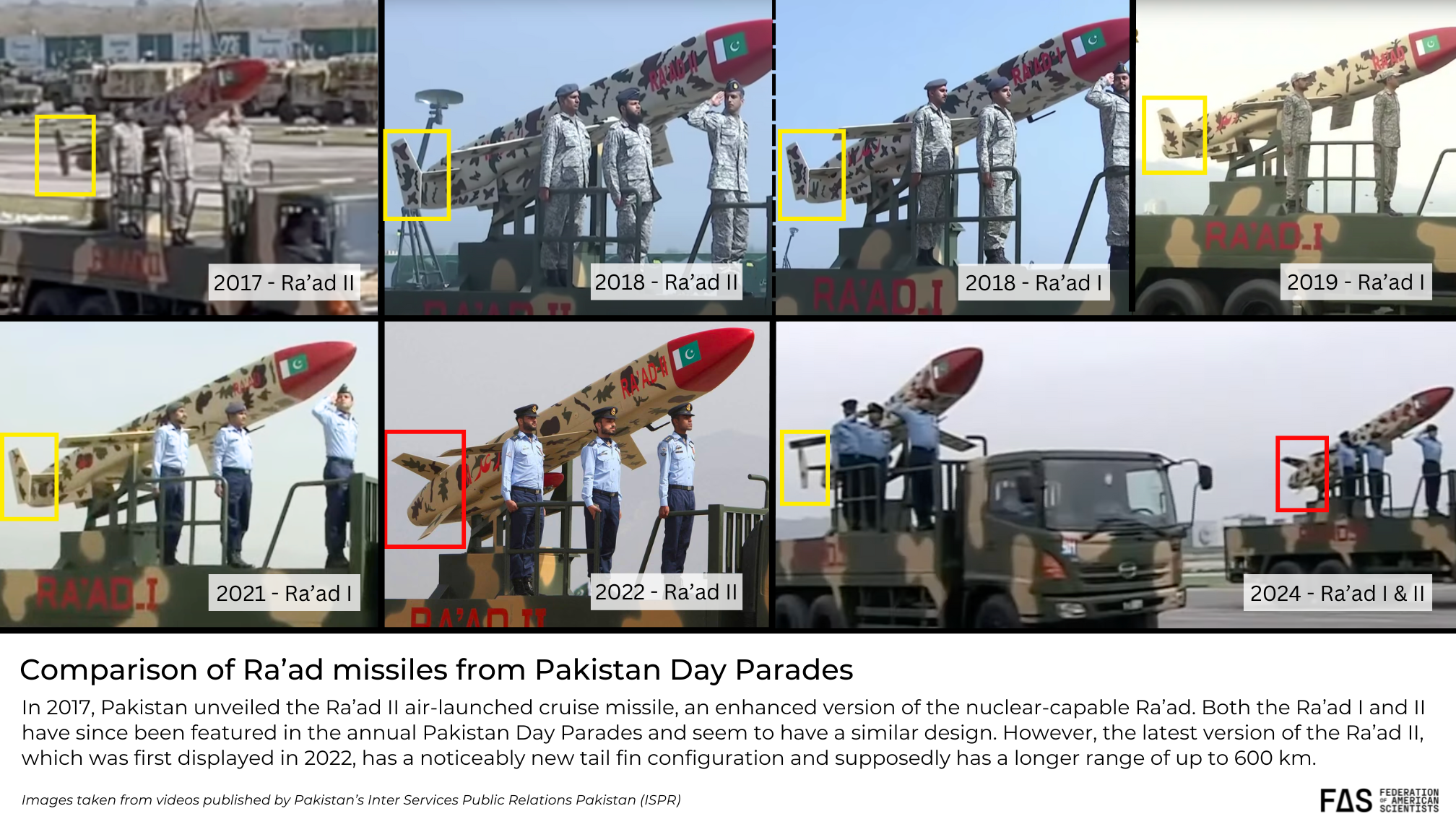
In 2017, Pakistan unveiled the Ra’ad Il air-launched cruise missile, an enhanced version of the nuclear-capable Ra’ad. Both the Ra’ad I and II have since been featured in the annual Pakistan Day Parades and seem to have a similar design. However, the latest version of the Ra’ad II, which was first displayed in 2022, has a noticeably new tail fin configuration and supposedly has a longer range of up to 600 km.
However, in 2022, a new version of the Ra’ad-II was displayed at the 2022 Pakistan Day Parade. Notably, this new version had an ‘x-shaped’ tail fin configuration as opposed to the other ‘twin-tail’ configurations seen in previous versions of the missile. The subsequent 2024 Pakistan Day parade also showcased the two distinct versions of the Ra’ad with their respective tail fin arrangements.
The fin arrangements of the photographed missile on the JF-17 appear to more closely match the ‘twin-tail’ configuration of the Ra’ad-I, rather than the newer ‘x-shaped’ tail of the Ra’ad-II, especially since it is unlikely that an outdated version of the Ra’ad II would be utilized in a flight test intended to demonstrate state-of-the-art capabilities.
Pakistan is also developing a conventional, anti-ship variant of the Ra’ad ALCM, known as Taimoor, that can be launched from the JF-17. Photos of the missile indicate that the two designs are highly similar, although the Taimoor missile also appears to include an ‘x-tail’ fin configuration, and its length is reported to be 4.38 meters. The ‘x-tail configuration’ would appear to indicate that the missile photographed on the JF-17 was not the Taimoor; however, for additional clarity, we measured multiple parade images of both versions of the Ra’ad and compared their lengths to that of the photographed missile.
We took an image of the Ra’ad-I from the 2019 Pakistan Day Parade and used the Vanishing Point feature in Photoshop to add gridded planes that simulate a 3D space in order to account for the angle at which the image was taken and the depth at which the missile sits compared to the side of the truck. After finding the make and model of the vehicle carrying the missile (which appears to be an early version of the Hino 500 Series FM 2630), we used the truck’s trailer axle spread of approximately 1.3 meters and wheelbase of 4.24 meters reference values and used Photoshop’s measuring tool to render an approximate length. We found it to be around 4.9 meters.
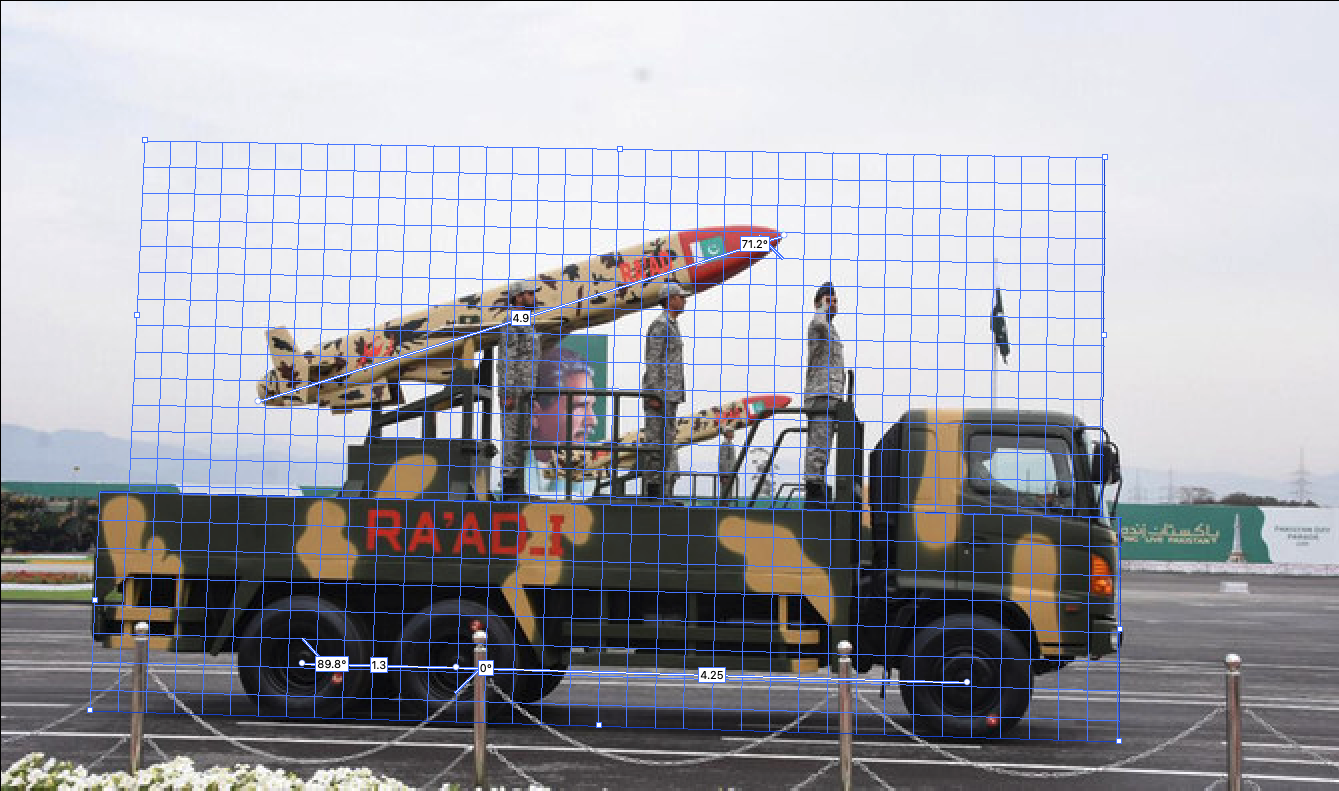
To estimate the dimensions of the Ra’ad-II, we started with a photo from the 2022 Pakistan Day Parade. Using the same methodology with Photoshop’s Vanishing Point tool to account for the angle of the photo and the distance from the missile’s position in the center of the vehicle to the foremost gridded plane that measures the length of the truck, we roughly estimated the size of the missile to be around 4.9 meters.
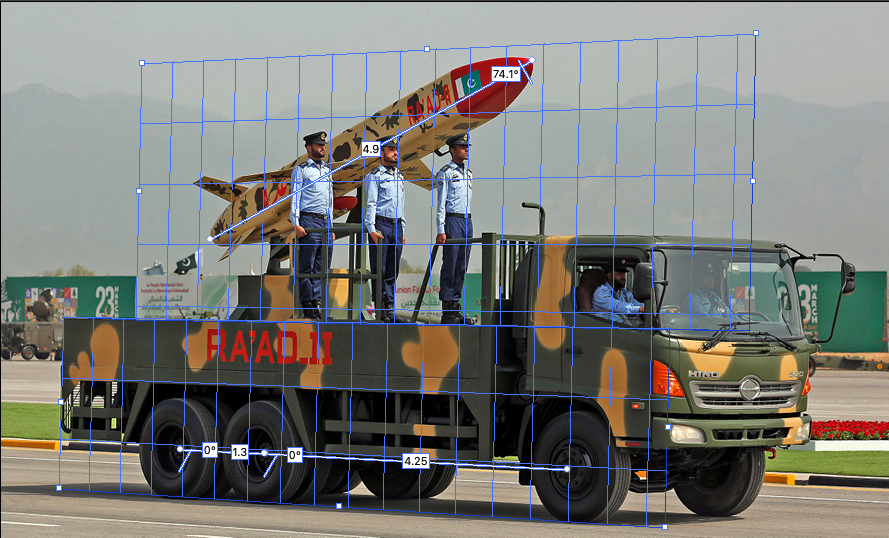
We also double-checked the dimensions of the cruise missile in the JF-17 image. Since we know that the JF-17 is roughly 14.3 meters long, we used that number as a reference value and employed Photoshop’s Vanishing Point and measuring tool again to render an approximate length of the missile, given its lowered position in relation to the edge of the fuselage. The result was 4.9 meters, which matches the reported dimensions of the Ra’ad-I and -II ALCM as well as our estimated measurements. This measurement is also longer than the Taimoor’s reported 4.38-meter length.

While it is possible that the missile could be an old Ra’ad-II, given that the 2017 version also had a ‘twin-tail’ configuration, that version of the Ra’ad-II appears to be outdated and is therefore unlikely to be utilized in a flight test. Still, it is possible that more information, images, or statements from the Pakistan government could surface that answer some of these questions.
Observing the differences between the Ra’ad-I and Ra’ad-II missiles raises a few questions. How was Pakistan able to nearly double the range of the Ra’ad from an estimated 350 km to 550 km and then to 600 km for the newest version without noticeably changing the size of the missile to carry more fuel? The answer could possibly be that the Ra’ad-II engine design is more efficient, the construction components are made from lighter-weight materials, or the payload has been reduced.
These measurements offer additional evidence to support our conclusion that the missile observed in the photographed image of the JF-17 is the Ra’ad-I ALCM.
Implications for Pakistan’s nuclear forces
Given the lack of publicly available information from the government of Pakistan about its nuclear forces, we must rely on these types of analyses to understand the status of Pakistan’s nuclear arsenal. From these observations, it is likely that Pakistan has made significant progress toward equipping its JF-17s with the capability to eventually supplement–and possibly replace–the nuclear strike role of the aging Mirage III/Vs. Additionally, it is evident that Pakistan has redesigned the Ra’ad-II ALCM, but little information has been confirmed about the purpose or capabilities associated with this new design. It is also unclear whether either of the Ra’ad systems has been deployed, but this may only be a question of when rather than if. Once deployed, it remains to be seen if Pakistan will also continue to retain a nuclear gravity bomb capability for its aircraft or transition to stand-off cruise missiles only.
This all takes place in the larger backdrop of an ongoing and deepening nuclear arms competition in the region. Pakistan is reportedly pursuing the capability to deliver multiple independently targetable re-entry vehicles (MIRVs) with its Ababeel land-based missile, while India is also pursuing MIRV technology for its Agni-P and Agni-5 missiles, and China has deployed MIRVs on a number of its DF-5B ICBMs and DF-41. In addition to the Ra’ad ALCM, Pakistan has also been developing other short-range, lower-yield nuclear-capable systems, such as the NASR (Hatf-9) ballistic missile, that are designed to counter conventional military threats from India below the strategic nuclear level.
These developments, along with heightened tensions in the region, have raised concerns about accelerated arms racing as well as new risks for escalation in a potential conflict between India and Pakistan, especially since India is also increasing the size and improving the capabilities of its nuclear arsenal. This context presents an even greater need for transparency and understanding about the quality and intentions behind states’ nuclear programs to prevent mischaracterization and misunderstanding, as well as to avoid worst-case force buildup reactions.
The author would like to thank David La Boon and Decker Eveleth for their invaluable guidance and feedback on using Photoshop’s Vanishing Point feature.
Correction: After the article’s publication, the final image was removed and replaced with the correct image. The language and conclusions of the piece remained unchanged.
This research was carried out with generous contributions from the Carnegie Corporation of New York, the New-Land Foundation, Ploughshares, the Prospect Hill Foundation, Longview Philanthropy, and individual donors.
Nuclear Experts from the Federation of American Scientists Contribute to SIPRI Yearbook 2024
FAS’s Nuclear Information Project estimates that the combined global inventory of nuclear warheads is approximately 12,120
Washington, DC – June 17, 2024 – The Federation of American Scientists’ nuclear weapons researchers Hans Kristensen and Matt Korda with the Nuclear Information Project write in the new SIPRI Yearbook, released today, that the world’s nuclear arsenals are on the rise, and massive modernization programs are underway.
“China is expanding its nuclear arsenal faster than any other country,” said Hans M. Kristensen, Associate Senior Fellow with SIPRI’s Weapons of Mass Destruction Programme and Director of the Nuclear Information Project at the Federation of American Scientists (FAS). “But in nearly all of the nuclear-armed states, there are either plans or a significant push to increase nuclear forces.”
“We are entering a new period in the post-Cold War era as nuclear stockpiles increase and nuclear transparency decreases. It is, therefore, extremely important for independent researchers to inject factual data into the debate,” says Matt Korda, Associate Researcher in the SIPRI Weapons of Mass Destruction Programme and Senior Research Fellow at FAS.
Kristensen and Korda are leading researchers on the global stockpile of nuclear weapons. Along with their colleagues Eliana Johns and Mackenzie Knight, the Nuclear Information Project team at FAS produces the Nuclear Notebook, a bi-monthly report published in the Bulletin of Atomic Scientists detailing current estimates of nuclear weapon stockpiles. This work plays an increasingly important role as government transparency about nuclear forces continues to decline around the globe. Ongoing reports, archives, and other materials are available at fas.org.
The first edition of the SIPRI Yearbook was released in 1969, with the aim of producing “a factual and balanced account of a controversial subject-the arms race and attempts to stop it.” Interested parties may download excerpts from the latest Yearbook in several languages here, or purchase the report in full.
Read a summary of SIPRI findings by FAS Nuclear Information Project researcher Eliana Johns here.
###
ABOUT FAS
The Federation of American Scientists (FAS) works to advance progress on a broad suite of contemporary issues where science, technology, and innovation policy can deliver dramatic progress, and seeks to ensure that scientific and technical expertise have a seat at the policymaking table. Established in 1945 by scientists in response to the atomic bomb, FAS continues to work on behalf of a safer, more equitable, and more peaceful world. More information at fas.org.
America’s Nuclear Weapons Arsenal 2024: Annual Overview Released by the Federation of American Scientists
FAS researchers, in partnership with the Bulletin of Atomic Scientists, release this seminal account each year in the “Nuclear Notebook”
Washington, D.C. – May 7, 2024 – Nuclear experts at the Federation of American Scientists (FAS) today released “Nuclear Notebook: United States Nuclear Weapons 2024,” an annual overview of the current status and trends of the U.S. nuclear weapons arsenal. The FAS Nuclear Notebook is widely considered the most accurate public source for information on global nuclear arsenals for all nine nuclear-armed states.
This year’s report, produced in partnership with the Bulletin of Atomic Scientists and available in full here, shows the following nuclear trends as Americans enter a presidential election year:
- Across-the-board nuclear modernization is well underway;
- The modernization plan initially envisioned life-extending existing warheads for existing force structure but is evolving into a more ambitious program of new warhead designs and additional weapon types;
- Significant parts of the modernization program are challenged by rising costs and delays (for example, the Sentinel ICBM program is projected to cost 37% more than just four years ago);
- Deployment of new B61-12 guided nuclear bomb to Europe imminent;
- Strategic competition with Russia and China fuel calls for more nuclear weapons;
- Despite calls for transparency of adversarial arsenals, nuclear secrecy at home has increased.
In this issue of the Nuclear Notebook, FAS estimates that the United States maintains a stockpile of approximately 3,708 warheads—an unchanged estimate from the previous year. The total number of U.S. nuclear warheads are now estimated to include 1,770 deployed warheads, 1,938 reserved for operational forces. An additional 1,336 retired warheads are awaiting dismantlement, for a total inventory of approximately 5,044 warheads.
Of the deployed warheads, FAS estimates 400 are on intercontinental ballistic missiles [ICBMs], 970 on submarine-launched ballistic missiles [SLBMs], and 300 are located at bomber bases in the United States and approximately 100 tactical bombs are at European bases.
The United States has embarked on a wide-ranging nuclear modernization program that will ultimately see every nuclear delivery system replaced with newer versions over the coming decades. The total cost of this modernization could reach over $1.7 trillion. Calls to increase the nuclear arsenal would increase cost further and compete with non-nuclear defense needs.
The New START treaty, established in 2010 between the United States and Russia, has proven useful so far in keeping a lid on both countries’ deployed strategic forces. But the treaty expires in February 2026 and a decision to renew or not will be made by the next administration. If it is not followed by a new agreement, both the United States and Russia could potentially increase their deployed nuclear arsenals by uploading several hundred of stored reserve warheads onto their launchers.
FAS Nuclear Experts and Previous Issues of Nuclear Notebook
The FAS Nuclear Notebook, co-authored by Hans M. Kristensen, Matt Korda, Eliana Johns, and Mackenzie Knight, is published bi-monthly in the Bulletin of the Atomic Scientists. The joint publication began in 1987. FAS, formed in 1945 by the scientists who developed the nuclear weapon, has worked since to increase nuclear transparency, reduce nuclear risks, and advocate for responsible reductions of nuclear arsenal and their role.
This latest issue on the United State’s nuclear weapons comes after the release of Nuclear Notebook: Russian Nuclear Forces, 2024 on Russia’s nuclear arsenal. More research is located at FAS’s Nuclear Information Project.
###
ABOUT FAS
The Federation of American Scientists (FAS) works to advance progress on a broad suite of contemporary issues where science, technology, and innovation policy can deliver dramatic progress, and seeks to ensure that scientific and technical expertise have a seat at the policymaking table. Established in 1945 by scientists in response to the atomic bomb, FAS continues to work on behalf of a safer, more equitable, and more peaceful world. More information at fas.org.
Depot In Belarus Shows New Upgrades Possibly For Russian Nuclear Warhead Storage
A military depot in central Belarus has recently been upgraded with additional security perimeters and an access point that indicate it could be intended for housing Russian nuclear warheads for Belarus’ Russia-supplied Iskander missile launchers.
The upgraded enclosure is located inside an existing military depot east of the town of Ashipovichy. Leaked documents on Discord indicated that in February 2023, the CIA reported that “a senior officer from the Russian Ministry of Defense inspected a facility in the vicinity of Asipivochy [sic] for potential upgrades” to serve as “a nuclear warhead storage facility in Belarus” (see excerpt of CIA leaked report below).

This part of a leaked CIA document reported Russian inspection of Asipovichy for potential nuclear warhead storage.
A satellite image provided by Maxar Technologies shows that part of the depot near Asipovichy has since been upgraded with a quadruple-fence security perimeter and a roof-covered guarded access point (see image below).
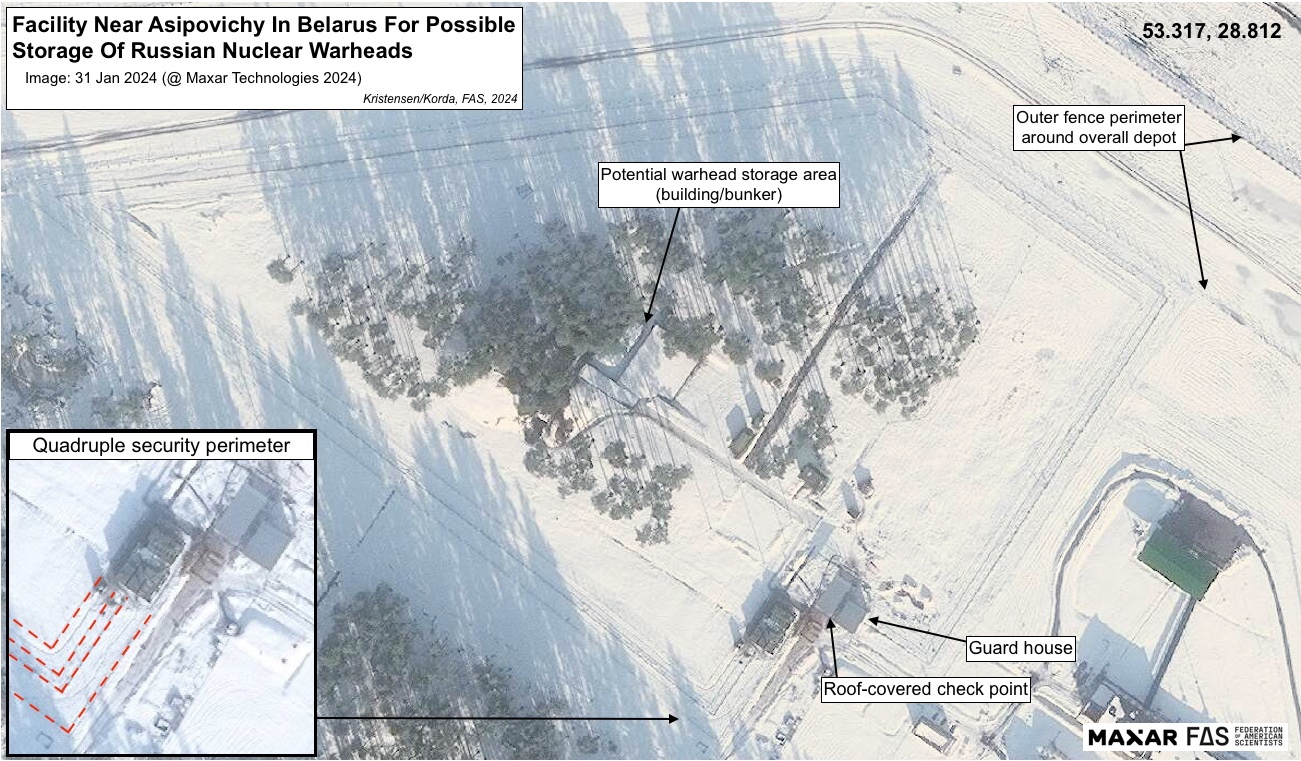
Upgrades to Asipovichy depot now shows quadruple security perimeter.
Satellite images show that construction began at the facility around the time of the reported visit by the senior Russian official. The upgrades have progressed slowly, with the initial construction of a double-layer security perimeter. That would be insufficient for storage of nuclear warheads. In October 2023 construction of a new perimeter began inside the existing security perimeter, and the Maxar image from late-January 2024 shows what appears to be a total of four security perimeters. The construction of the added perimeters shows significant digging for what could potentially be cables and various sensors. Trees within the new inner perimeter have also been cleared by approximately 20 meters away from the fencing.
If so, these upgrades would more closely resemble the level of physical protection that Russian authorities would require for storage of nuclear weapons.
Russian and Belarusian statements over the past two years have repeatedly claimed that nuclear weapons had been brought to Belarus, but we had previously not seen clear evidence that facilities had been readied for that purpose.
Earlier today, under the headline “Russian Nuclear Weapons Are Now In Belarus,” Foreign Policy reported that “Western officials,” including the Lithuanian defense minister, “confirmed the news of the deployment.” The article says that “a senior Lithuanian diplomat and other Western officials indicated to Foreign Policy that Russia had built specific storage facilities and railway systems in Belarus to potentially house a nuclear arsenal.”
It remains unclear if the confirmations referred to nuclear-capable launchers or the actual warheads for those launchers. But the upgrade at the Asipovichy depot shows security features that potentially could match upgrades required for nuclear warhead storage at the same facility that the Russian defense official apparently inspected one year ago.
If nuclear warheads have indeed been moved to Belarus, it does not give Russia a significant military advantage in eastern Europe. Russia already maintains modernized nuclear storage facilities in Kaliningrad and has long had the ability to target NATO countries with nuclear weapons. Instead, the deployment appears designed to unnerve NATO’s eastern-most member states and highlight Russia’s status as a nuclear power.
Additional background information:
• Nuclear Weapons Sharing, 2023
• Belarus “Nuclear-Capable” Iskanders Get A New Garage
• Russian Nuclear Weapons Deployment Plans In Belarus: Is There Visual Confirmation?
• Russian Nuclear Weapons In Belarus? A CNS Roundtable Discussion
• Video Indicates That Lida Air Base Might Get Russian “Nuclear Sharing” Mission In Belarus
• Geo-Location of Russian-Supplied Iskander Launchers Training at Osipovichi i Belarus
This research was carried out with generous contributions from the the New-Land Foundation, Ploughshares Fund, the Prospect Hill Foundation, Longview Philanthropy, and individual donors.
Indian Test-Launch of MIRV Missile Latest Sign Of Emerging Nuclear Arms Race
The Indian government announced yesterday that it had conducted the first flight test of its Agni-5 ballistic missile “with Multiple Independently Targetable Re-Entry Vehicle (MIRV) technology.
While the Indian government may rejoice in its technical achievement, the proliferation of MIRV capability is a sign of a larger worrisome trend in worldwide nuclear arsenals that is already showing signs of an emerging nuclear arms race with more de-stabilizing MIRVed missiles.
A photo of the launch published by the Indian Defense Research and Development Organization (DRDO) shows that the payload section has been significantly modified compared with the Agni-5 missiles used in earlier tests (see below).
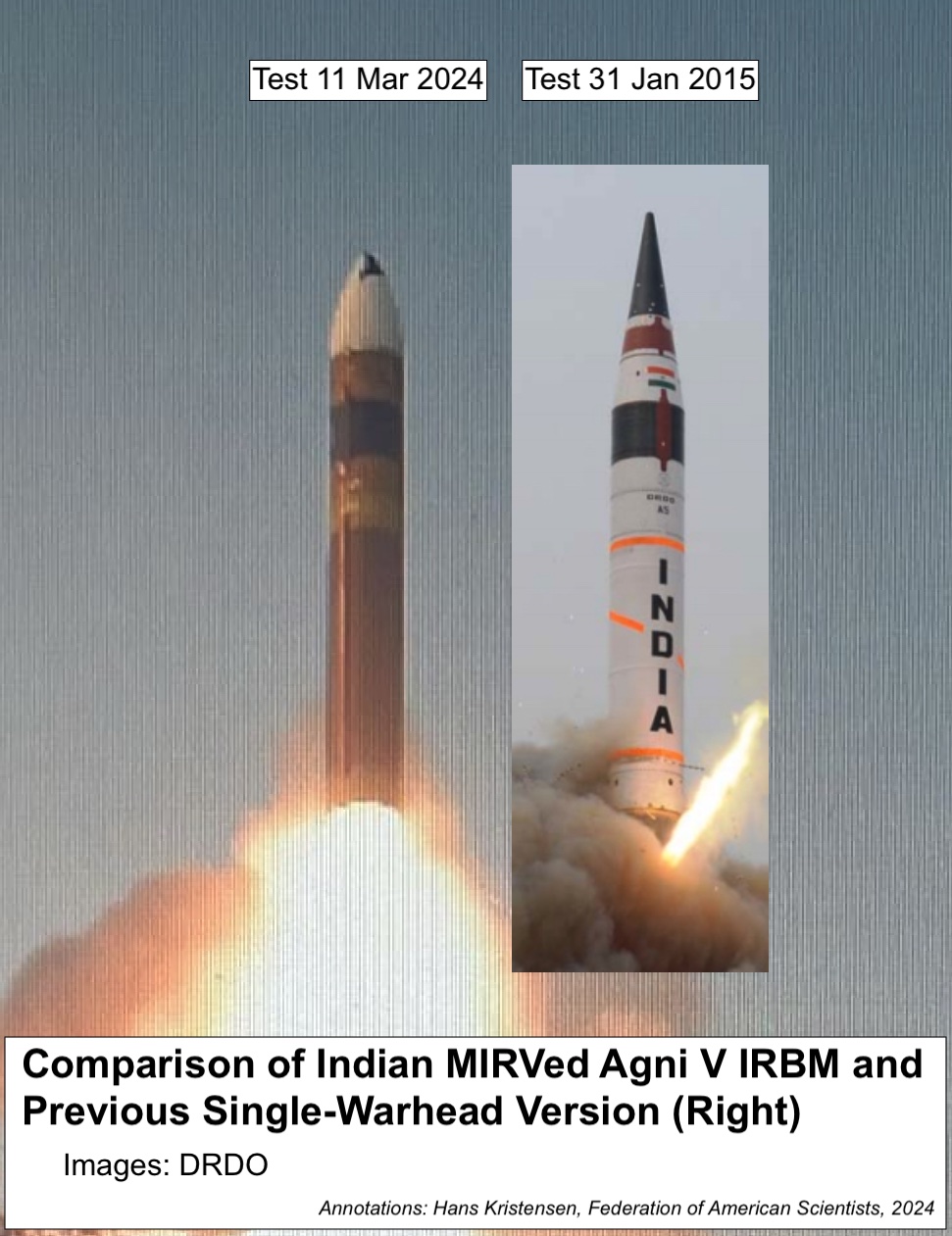
A Planet Labs satellite image dated 9 March 2024 shows what appears to be an Agni-5 road-mobile launcher parked on the launch pad at the missile test launch facility on Abdul Kalam Island on India’s north-east coast. This is presumably the launcher that was used to test launch the MIRVed Agni-5 two days later (see image below).
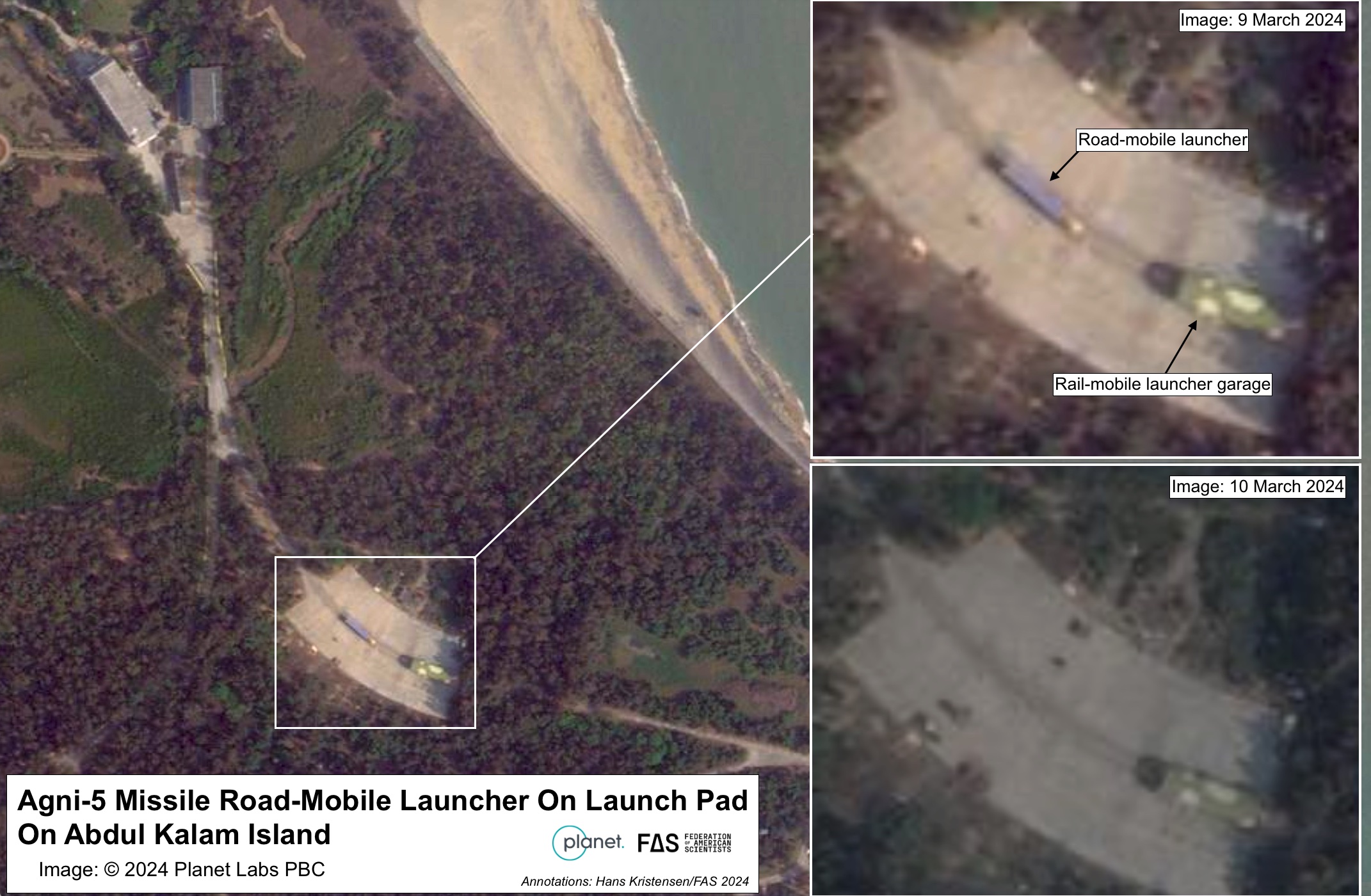
Reports have circulated for two decades about the Indian defense industry working on MIRV technology. Some have suggested that a MIRV capability might exist for the Agni-3 medium-range missile, which is currently being fielded with the Indian army, but this has not yet been confirmed. Unconfirmed press reports also said that an Agni-P medium-range missile test in December 2021 carried two reentry vehicles to simulate MIRV capability.
The Indian government says that the latest Agni-5 test––named Mission Divyastra––was the first time that this missile had successfully demonstrated MIRV technology. If so, it will likely take several additional flight tests to complete the development of an operational MIRV capability for the Agni-5. Yet the test-launch demonstration of MIRV capability on the Agni-5 with a significantly modified payload section marks a significant development for India’s nuclear posture, and faster than we anticipated just a few years ago.
Significant integration work on Agni-5 road-mobile launchers has been visible at the Shampirpet Missile Complex northeast of Hyderabad for the past several years (see image below). The launchers appear to match the one seen on Abdul Kalam Island.
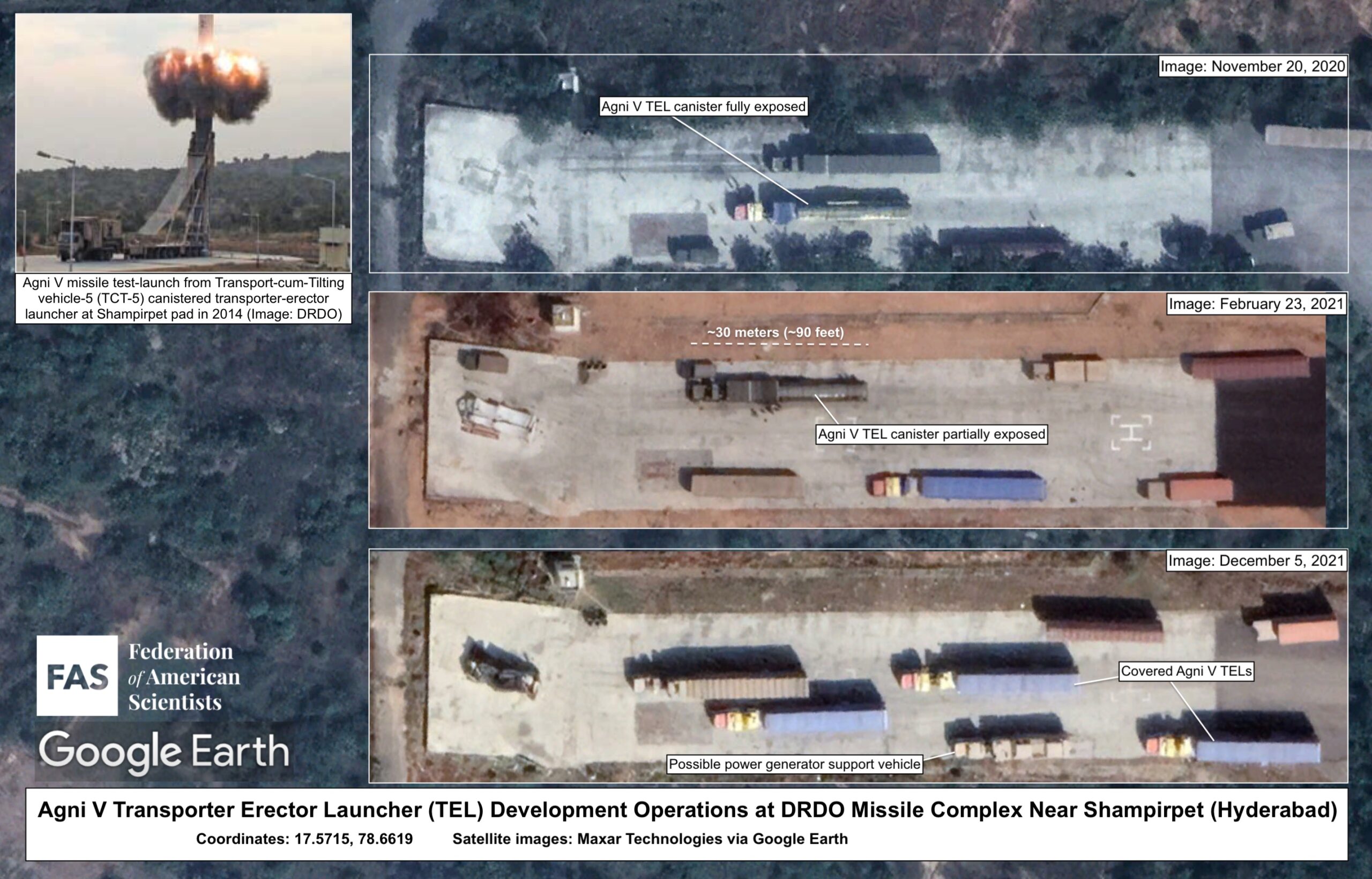
The bigger picture is that India’s pursuit of MIRV capability is a warning sign of an emerging arms race: It follows China’s deployment of MIRVs on some of its DF-5 ICBMs, Pakistan’s apparent pursuit of MIRVs for its Ababeel medium-range missile, North Korea may also be pursuing MIRV technology, and the United Kingdom has decided to increase its nuclear stockpile to enable it to deploy more warheads on its submarine-launched missiles.
This proliferation of MIRV capability follows the failure of the United States and Russia to implement the ban on MIRV on land-based missiles they agreed to in the START-II treaty in the 1990s. Instead, Russia is replacing all its single-warhead ICBMs with types capable of carrying multiple warheads, and there is a push in the United States to re-MIRV its deployed ICBMs.
The capability to deploy multiple warheads on each missile is one of the most dangerous developments of the nuclear era because it is one of the quickest ways for nuclear-armed states to significantly increase their number of deployed warheads and develop the capability to rapidly destroy large numbers of targets. Back in the 1960s and 1970s, MIRV capability resulted in a massive increase of US and Soviet nuclear arsenals. And MIRVing is a key element of the US projection that China might have 1,000 operational warheads by 2030. When the New START treaty expires in two years and the United States and Russia fail to agree to new limits on their strategic forces, both countries could upload hundreds of additional warheads onto their already deployed systems.
Although all 400 deployed US ICBMs currently only carry a single warhead, about half of them use the Mk21A reentry vehicle that is capable of carrying up to three warheads each. The United States could also upload each of its deployed Trident SLBMs with a full complement of eight warheads, rather than the current average of four to five. Meanwhile, we estimate that Russia also maintains a significant upload capacity, given that many of their ICBMs and SLBMs had been previously downloaded in order to meet New START’s central limits on deployed warheads. For both countries, these changes could be made within weeks to months for the submarines, and within months to years for the ICBMs.
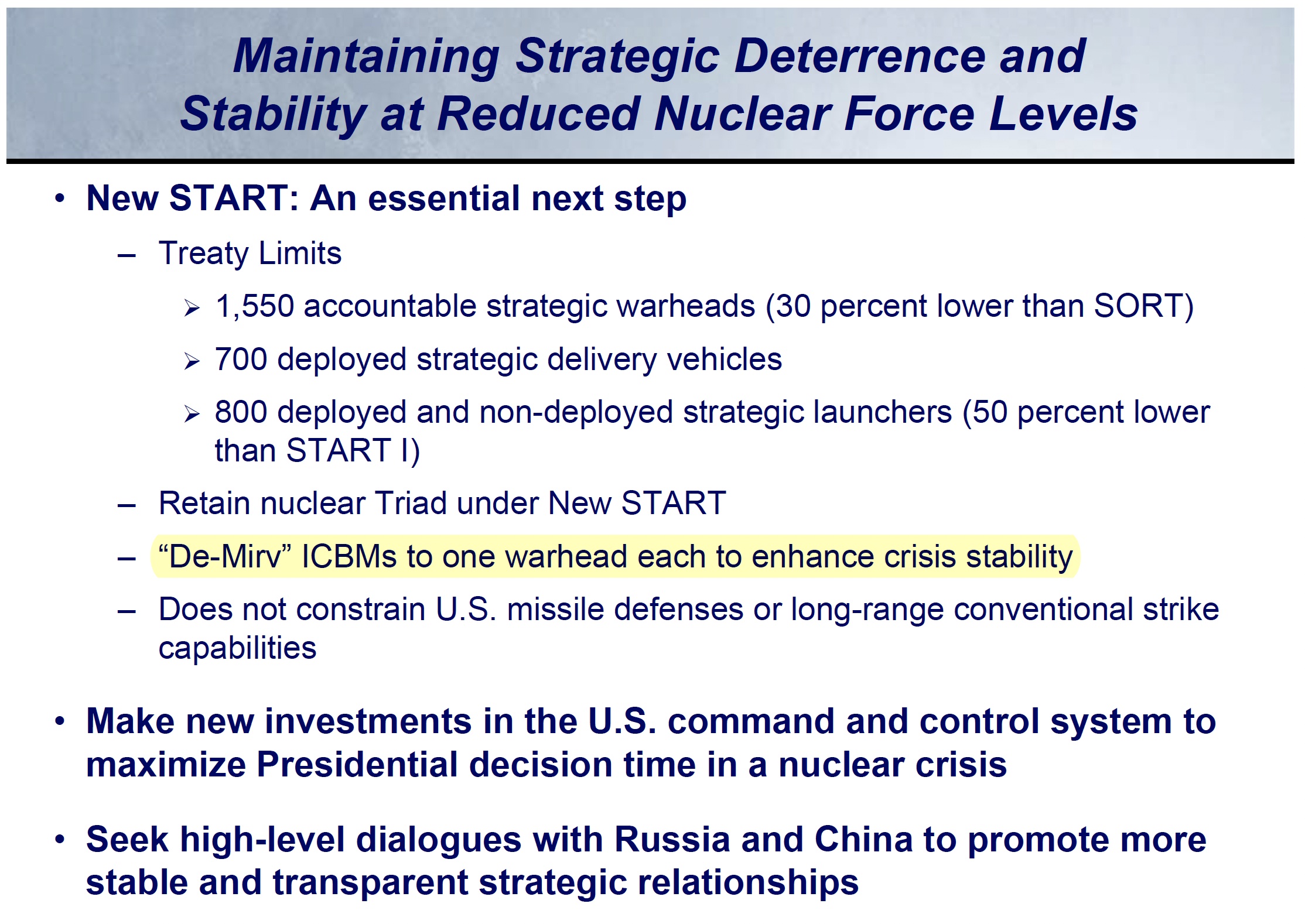
The US decided to “de-MIRV” its ICBMs in recognition of the de-stabilizing effect of MIRV on land-based ballistic missiles.
A world in which nearly all nuclear-armed countries deploy significant MIRV capability looks far more dangerous than our current geostrategic environment. This is because the highly destructive capacity of MIRVs means that they are both potential first-strike weapons and juicy first-strike targets. Not only would widespread MIRV deployments likely spur on the global nuclear arms competition by deepening worst-case force posture planning, but it would dramatically reduce crisis stability by incentivizing leaders to launch their nuclear weapons quickly in a crisis (the US explicitly decided to “de-MIRV” its deployed ICBMs to “enhance crisis stability”).
One would think, despite their differences, that all nuclear-armed states should be able to agree that a MIRV-race is neither in their national security interests nor those of the rest of the world. But we’re not holding our breath.
This research was carried out with generous contributions from the New-Land Foundation, Ploughshares Fund, the Prospect Hill Foundation, Longview Philanthropy, and individual donors.